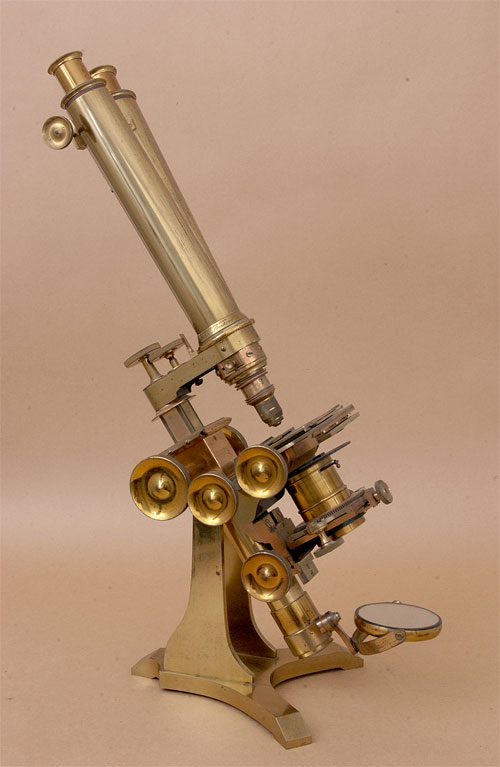 |
|||||
 |
 |
||||
 |
|||||
 |
 |
||||

The optics of the microscope consist of a Huygenian eyepiece and an achromatic 1/10 inch objective lens. Just above the objective lens is a rectangular slider that contains a Wenham prism. When inserted the prism splits the image into two paths providing binocular vision, thus the microscope has two body tubes. Interpupilary distance is adjusted via a rack and pinion mechanism. Wenham binocular microscopes were asymmetric with one straight tube and one side tube, and was useful only at low magnifications. Imaging is very good with no chromatic aberration. This microscope is a very fine example of the quality instruments that were designed and manufactured by Andrew Ross of London at the beginning of the 19th Century. The microscope is approximately 51cm tall. This microscope is engraved on the claw-foot base "Ross London, 3478". Ross began using serial numbers in 1843, which places the manufacture of this microscope around 1845.
Andrew Ross (1798Ð1859) was a well known and respected optician and instrument maker in London during the first quarter of the 19th Century. He began his career in 1813 by apprenticing to John Corless. In 1830 he separated from Corless and started his own business, much of the time in partnership with Joseph J. Lister. His company "Andrew Ross & Co." made a number of optical instruments including telescopes, however, he became well known for the quality of his achromatic lenses and high-quality microscopes. Ross introduced a number of improvements to compound microscopes, especially due to his collaboration with J.J. Lister in creating achromatic objectives. Ross' last instrument won first place at the Great Exibition of 1851. In 1830 he received the Gold Isis Medal from the Society of Arts for his improved dividing astronomical and mathematical instruments and for his circular dividing engine. He received the same medal in 1836 for his improvements in achromatic objectives of microscopes. In 1841 he received a silver medal from the Society for his invention of the spherometer*. He separated from Lister c1842 and moved to 21 Featherstone Buildings, Holborn.
Ross was a founding member of the Microscopical Society of London, which later became the Royal Microscopical Society. Ross made microscopes from 1831 through 1859, after which the company became "Ross & Co." under the direction of his son Thomas. Thomas' company continued making lenses under the "Ross" name until it merged with Barnet Ensign in 1948. In 1975 the company finally lost the "Ross" name when it was absorbed by first Avimo then eventually Thales Optics.
*see http://vayafigura.files.wordpress.com/2010/02/ross-1930-1945.pdf
This microscope was featured 01/2015